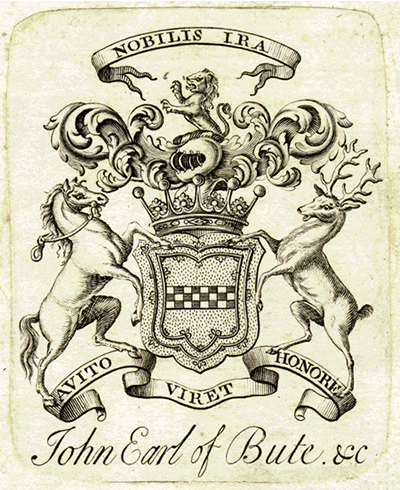A Complete Heraldic Achievement
The shield when displayed with all its surrounding parts is termed a complete achievement. The achievement shown below, from the bookplate of John, 3rd Earl of Bute, can be blazoned as follows:
A shield supported dexter by a horse, bridled, and sinister by a stag, both proper, with an earl's crown, helmet, mantle, and crest.
ARMS: or a fess chequy argent and azure within a tressure flory-counterflory gules.
CREST: a demi-lion rampant gules with motto scroll above.
MOTTO: Nobilis ira; Avito viret honore.
The above format for blazoning is that which has been followed in describing the various armorials which appear in the Bookplate Database. In addition to the illustration below, verbal desciptions of the various components of the complete armorial are given after the illustration. Please note that these descriptions include two components not illustrated here: the compartment or ground, and medals or chains from orders of knighthood.
Crest: A figure or symbol affixed to the top of a helmet, usually derived from or relating to the arms on the shield. The crest sits on the torse, a wreath created by twisting the primary color and metal together.
Mantle: Derived from the cloth worn over the helmet as protection from the sun. The outer color is traditionally the primary color in the arms, while the lining is traditionally the primary metal.
Helm: Deriving from the helmets worn in battle, the stylized helm sometimes signifies the rank of the person whose arms it accompanies. [See Crowns, Helmets, Chaplets & Chapeaux]
Crown: Present only in the achievement of those entitled to bear it, the crown represents the rank of a noble. [See Crowns, Helmets, Chaplets & Chapeaux]
Shield: The main part of the achievement, the shield is also called the coat-of-arms, arms, or armorial. The design of the arms is exclusive to the individual to whom they are granted, although the arms of individuals within the same family often are highly similar. [See Instructions for Blazoning a Coat-of-Arms]
Supporters: Originally decorative in nature, supporters came to be considered part of a speciffic individual's achievement. They now appear only in the arms of governments, titled families, and those in positions of authority.
Ground: When an achievement includes supporters there is sometimes provided a visual element for them to stand upon. This object may appear as a natural form (eg. a hill) or as a decorative bracket. May also be referred to as the compartment.
Insignia: A person who had been knighted by one of the various British and European Orders would usually display the insignia of the order (often the collar or badge) around or behind the shield in their armorial. None are present in the example above.
Motto: Mottos are not exclusive to an individual or family, but are rather chosen by the individual to express an ideal, goal, or admonition. They are often in Latin, although not necessarily so.
General RBSC Hours
- Mon - Fri
- 9:30am - 4:30pm
- Sat - Sun
- CLOSED
For exceptions and Hesburgh Library information, view All Library Hours


 |
| 